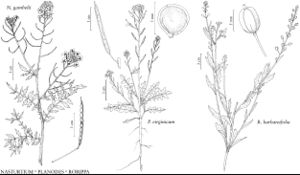Planodes
Leafl. Bot. Observ. Crit. 2: 220. 1912.
| Taxon | Illustrator ⠉ | |
|---|---|---|
 | Nasturtium gambelii Planodes virginicum Rorippa barbareifolia | Yevonn Wilson-Ramsey Yevonn Wilson-Ramsey Barbara Alongi |
Annuals (sometimes winter); not scapose; pubescent or glabrous. Stems erect or ascending to decumbent, often branched distally. Leaves basal and cauline; petiolate; basal (loosely) rosulate, blade margins pinnatifid to pinnatisect, (lobes) dentate or entire; cauline similar to basal. Racemes (corymbose, several-flowered), considerably elongated in fruit. Fruiting pedicels divaricate-ascending, slender. Flowers: sepals erect, oblong, lateral pair not saccate basally; petals white, oblanceolate, (longer than sepals), claw undifferentiated from blade, (apex obtuse); stamens slightly tetradynamous; filaments not dilated basally; anthers ovate, (apex obtuse); nectar glands lateral (minute), 1 on each side of lateral stamen. Fruits siliques, sessile or subsessile, linear, torulose, straight, latiseptate; valves each with obscure midvein, glabrous; replum rounded; septum complete; ovules (20–) 28–44 per ovary; style distinct (conical); stigma capitate. Seeds uniseriate, flattened, narrowly winged, orbicular or suborbicular; seed-coat not mucilaginous when wetted; cotyledons accumbent. x = 8.
Distribution
c, s United States, nw Mexico
Discussion
Species 1.
Planodes virginicum has floated among Arabis, Cardamine, and Sibara. However, it is distinct from all three both morphologically and phylogenetically, and it appears to be most closely allied to Cardamine. It is known from Baja California; in the southeastern and some of the central United States, it has become weedy, especially in cultivated or abandoned fields.
Selected References
Lower Taxa
"elongated" is not a number."thick" is not a number.